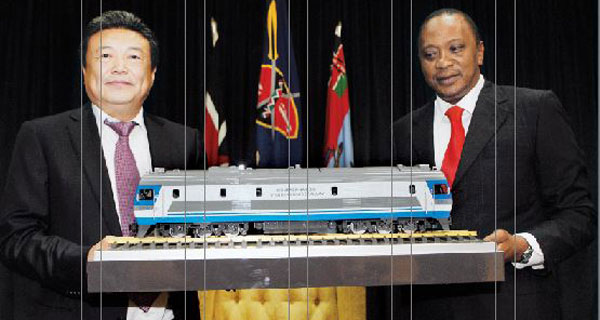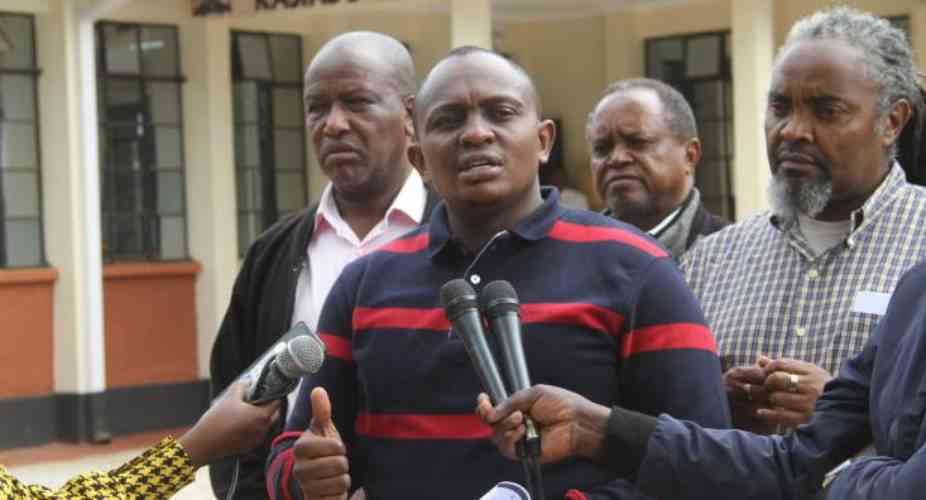 |
|
President Uhuru Kenyatta receives a model of a modern train from the President of China Road and Bridge Corporation Wen Gang at State House, Nairobi. The firm will build a standard gauge rail that will run from Mombasa to Malaba. [PHOTO: PSCU] |
By MACHARIA KAMAU and TIMOTHY MACHI
Kenya: Kenya this Thursday embarks on a process that will make stale the joke that it has not added an inch to its colonial-era railway line.
Presidents Uhuru Kenyatta, Uganda’s Yoweri Museveni, Rwanda’s Paul Kagame and South Sudan’s Salva Kiir are set to break ground for the Sh1.2 trillion high-speed Standard Gauge Railway (SGR) line that is expected to significantly transform the country’s state of transport.
More significantly, the modern rail system, which is planned to extend to Uganda, Rwanda and South Sudan, is expected to cement the country’s position as a regional gateway and transport hub.
Burundi is waiting in the wings to pick the line from Rwanda.
The 1,300km line originates from Mombasa running through Nairobi and Kisumu and terminates at Malaba.
In its first phase, the line runs from Mombasa to Nairobi along the current line with minimal deviations.
Construction is set to start immediately and the initial 450km between Mombasa and Nairobi expected to be operational by 2017.
The entire line linking the port of Mombasa to the border town of Kisangani, located between Rwanda and the Democratic Republic line will be ready by March 2018.
The standard gauge line, a key Vision 2030 flagship project, will typically present an opportunity for Kenya Railways to run freight trains with 54 double stack flat wagons carrying 216 twenty foot equivalent units (TEUs) per trip travelling at an average speed of 80km per hour.
Each passenger train will have a capacity of 960 passengers and will travel at a average speed of 120 kilometres per hour.
Trains using the new line will initially run on diesel and cruise at speeds of up to 120km per hour. Once the country is able to supply adequate electricity to the line, the trains will then be converted to electric. This will increase the speed to 160km per hour — covering the 519km Nairobi-Mombasa route in less than four hours.
The new rail can carry up to 4,000 tonnes (216 TEUs) in freight compared to just 1,000 tonnes (40 TEUs) on the current rail. Unlike the old metre gauge rail, the new standard gauge rail is also suitable for double-stacked containers, double-decker passenger cars and future electrification at 25 KV.
The use of trucks to ferry cargo from the port city to the rest of the country and the region has had significant impact on roads – damage, accidents and traffic hold ups – as well as the high cost that is usually passed on to consumers.
Cabinet Secretary for Transport and Infrastructure Michael Kamau recently noted that transport costs account for as much as 40 per cent of the cost of doing business in Kenya.
Stay informed. Subscribe to our newsletter
Analysts say the standard gauge railway line has potential to bring down the cost of transportation by as much as 79 per cent. This could mean a substantial reduction in commodity prices.
William Ojonyo, managing director Keynote Logistics, said in addition to the actual cost of transportation, railways are not prone to a substantial number of non-tariff barriers that are a factor when using road transport.
“The initial cost notwithstanding, I think the standard gauge rail is a step in the right direction,” Ojonyo said.
According to Prof Wainaina Gituro, acting Director-General of Vision 2030 Delivery Secretariat, 85 per cent of the Sh1.2 trillion for putting up the new standard gauge line has already been secured.
This, he said, will be covered by annual budgetary allocations made by the National Treasury, revenues collected through the 1.5 per cent railway development fund levy – that’s charged on all imported goods – and a loan from the Export Import (EXIM) Bank of China.
The Treasury in June set aside Sh22 billion this financial year that will go towards construction of the line. It also introduced a 1.5 per cent railway development fund levy that was operationalised in July.
According to the Kenya Revenue Authority, the railway fund was able to collect Sh5 billion in the July-September period, surpassing an initial target of Sh3 billion during the same quarter.
The levy has seen a rise in the cost of imported goods – including fuel – and Treasury expects to annually raise Sh22 billion through the levy. A further $3.3 billion (Sh280 billion) as a loan from the EXIM Bank of China covers more than 85 per cent of the total project costs.
 The Standard Group Plc is a
multi-media organization with investments in media platforms spanning newspaper
print operations, television, radio broadcasting, digital and online services. The
Standard Group is recognized as a leading multi-media house in Kenya with a key
influence in matters of national and international interest.
The Standard Group Plc is a
multi-media organization with investments in media platforms spanning newspaper
print operations, television, radio broadcasting, digital and online services. The
Standard Group is recognized as a leading multi-media house in Kenya with a key
influence in matters of national and international interest.
 The Standard Group Plc is a
multi-media organization with investments in media platforms spanning newspaper
print operations, television, radio broadcasting, digital and online services. The
Standard Group is recognized as a leading multi-media house in Kenya with a key
influence in matters of national and international interest.
The Standard Group Plc is a
multi-media organization with investments in media platforms spanning newspaper
print operations, television, radio broadcasting, digital and online services. The
Standard Group is recognized as a leading multi-media house in Kenya with a key
influence in matters of national and international interest.







